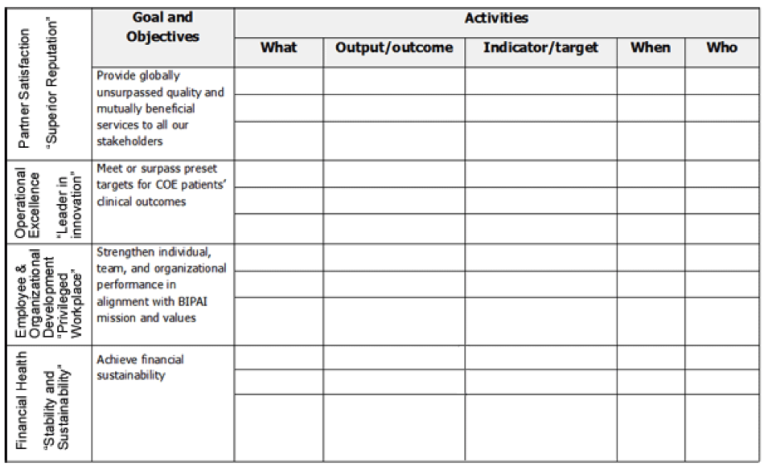
Resources Monitoring And Evaluation Framework
The comprehensive M&E framework has been created, facilitating program design, implementation, ongoing management and periodic evaluation. The rationale for developing a comprehensive monitoring and evaluation framework is premised on the following:
- The framework is designed to provide ongoing data to BIPAI at all levels in order to assist in the day-to-day management and improvement of services. As such it incorporates quality control elements intended to facilitate corrective and preventative action.
- The framework provides data on a predetermined episodic schedule for submission to government, funders and other interested stakeholders.
The HIV epidemic continues to shift. While most of the attention was focused on prevention in the early years, more attention is now needed for care and social support to PLWHA, their families and vulnerable children. In addition, the response to the epidemic has shifted from a health sector response to a multi-sector response. Strong monitoring and evaluation is needed to track the changing needs and to monitor the implementation and impact of the new programs.
National AIDS programs are increasingly funded by bilateral, multi-lateral and NGO support programs/funds. Efforts have been made to enhance collaboration and coordination on M&E issues between key donors at an international level; this requires equal collaboration, coordination and a strong focus at the country level.
- Collation, processing, analysis and interpretation of data
- Definitions of goals, objectives, activities, outputs, outcomes and associated performance indicators and targets designed to evaluate BIPAI’s progress in line with the four perspectives of the BSC: partner satisfaction, operational excellence, employee and organizational development and financial health.
- Definition of a list of core indicators that will enable tracking of progress in the most critical areas of the fight against HIV and AIDS
- Establishment of M&E logical frameworks and processes for the BIPAI strategic objectives of PMTCT, early infant diagnosis, outreach and training
- Description of the role that HIV-related operational research plays in the overall monitoring and evaluation of the HIV and AIDS programs
- Description of the key data sources to be used to gather necessary M&E data
- Description of the dissemination of products and mechanisms for the dissemination of all critical information amongst all stakeholders, implementing agencies, beneficiaries and the general public.
Like most M&E frameworks the BIPAI one has multiple audiences (stakeholders). The BIPAI M&E framework has divided the audience into internal and external audiences. The internal audience are the primary custodians or program implementers within the BIPAI network, while the external audience are the recipients of reports and evaluations emanating from the M&E processes. The principal external stakeholders are the governments with which we partner, our funders such as Texas Children’s Hospital, Abbott and Bristol-Myers Squibb and other collaborating partners such as UNICEF, USAID and the CDC. Internal stakeholders include BIPAI senior management and most levels of personnel within the network. The V.P. of M&E and the designated M&E specialists at each COE are the custodians of the framework, responsible for the correct dissemination of results and reports to all stakeholders.
The principal information products from the M&E framework are:
- The BIPAI quarterly network report
- Quarterly balanced score card report
- Detailed quarterly reports on operational excellence, including the basic clinical indicators and indicators defined for the strategic initiatives of PMTCT, early infant diagnosis, outreach, training and the impact of PAC
- Customized reports as required by funders and other stakeholders
- Annual evaluation reports from each country
- Overall network wide annual evaluation report
The V.P. of research and program evaluation has overall responsibility for the daily operation and maintenance of the BIPAI M&E framework. The BIPAI IT Director, assisted by the country IT specialists have responsibility for the daily operation and maintenance of the IT and software systems utilized to support the framework. The country M&E specialists have the following responsibilities:
- ongoing M&E training of COE personnel
- enforcement of internal QA processes for data collection and reporting
- conduct of data review according to the M&E framework schedule
- dissemination of M&E results to all staff
- conduct of investigations of issues and significant changes or irregularities
The Balanced Scorecard Approach uses four perspectives to monitor and evaluate the activities of the network as follows:
- Partner satisfaction
- Operational excellence
- Employee and organizational development
- Financial health

The first set of country BSCs were finalized by the end of May 2009 and implemented as of July 2009. Each county’s BSC is distinct, but all have the same overall goals within the same four perspectives. The most important aspects of the previously elaborated logical framework for operational excellence have been incorporated in the BSCs. However, more detailed data collection concerning operational excellence continues as described in the original 2008 M&E framework, including information on patient numbers and on training and mentoring of health care professionals, the basic clinical indicators derived from the EMR and indicators assessing initiatives such as PMTCT, early infant diagnosis, provider initiated testing and counseling and indicators evaluating the impact of our outreach activities.
